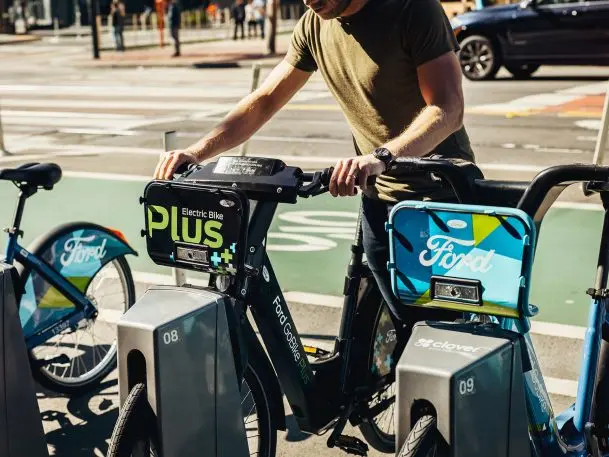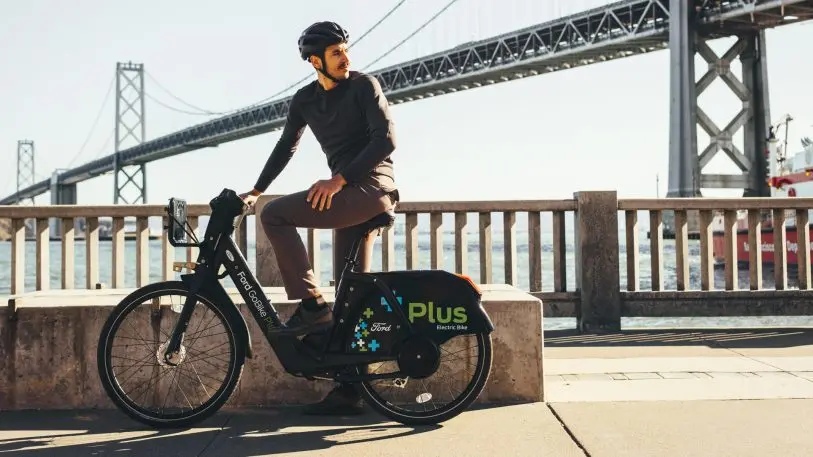In December, while visiting my family in Oakland for the holidays, I checked out a Ford GoBike Plus–one of the e-assist bikes that Lyft, the service operator, rolled out last year–to attempt the San Francisco hills I figured I’d never be able to ride on before. The e-bike changed that. The subtle push from the electric motor was enough to send me gracefully up steep ascents everywhere from Telegraph Hill through the Presidio without breaking a sweat. But while cruising down a descent on my way to dinner, I braked at the sight of a pedestrian–and it caused the bike to flip forward over the front wheel, sending me skidding on my knees down the rest of that hill.
I was fine, mostly, barring some lingering confusion: I’ve cycled down many hills before, often with heavy loads on the back of my bike, and I’ve never come close to tipping. This time, it seemed to happen instantaneously, with just a slightly tighter grip on the brakes.

It turned out, though, that it wasn’t just me. Enough people, according to Lyft spokesperson Julie Wood, were tossed from the e-bikes as the result of an overeager front braking mechanism that the company decided to pull all e-assist bikes from the three Lyft bike-share systems that have them: Ford GoBike, D.C.’s Capital Bikeshare, and New York’s Citi Bike.
“After a small number of reports and out of an abundance of caution, we are proactively pausing our electric bikes from service. Safety always comes first,” Wood said in a statement to Fast Company. Jump, the bike-share company now owned by Uber, reportedly modified the brakes on its electric bikes last year in response to similar issues.
The Lyft recall affected approximately 3,000 bikes across the three affected service areas. Lyft and Motivate, the bike-share service provider that Lyft acquired last year, worked quickly to ensure that the recalled e-bikes were replaced with standard pedal-power bikes. There is no timeline for when the e-bikes will be reinstated, but the company said that it’s in the process of developing a safer model.
In New York and D.C., apart from some griping at the loss of the speedy e-bikes, which can reach up to 18 miles per hour with little effort on the part of the rider, people adjusted. In both New York and D.C., e-bikes made up a much smaller proportion of the fleet: Just around 500 of Capital Bikeshare’s 4,300 bikes were electric, and around 1,000 of Citi Bike’s 12,000 bikes had a motor (though Lyft was preparing to up that number to 4,000 before the recall). In the Bay Area, nearly half–1,600 out of 3,500–of the available Ford GoBikes were e-assist.

There, the temporary loss of the e-bikes has had a significant impact on ridership. The infamous hills of the San Francisco Bay Area pose a considerable barrier to people who wish to casually cycle to work, especially on a typical Lyft bike, which weighs 45 pounds compared to standard bicycles, which typically clock in between 15 and 25 pounds. On Twitter, e-bike users have flooded Ford GoBike’s mentions with calls for the motorized bikes to return. One woman said her commute is now longer and she’s sweatier when she arrives at the office from navigating the hills, and multiple others said the introduction of e-bikes was “transformational” for how they navigated the Bay Area.
According to data from Lyft, the e-bike recall has correlated with an overall decline is system usage across the Bay Area, while in New York and D.C., ridership levels have held steady (if a bit sweatier).
What the effect of introducing, then taking away, e-bikes does show unequivocally is that there’s an appetite for convenient, alternative transportation in crowded markets. In the Bay Area, traffic has worsened significantly since the tech boom, and the public transit network has not kept pace. The arrival of e-bikes, which launched just a year ago in the Bay Area, filled a significant void in the local options for clean, fast, and affordable options to move from one place to another. The motors flatten out the hills and position cycling more as a mode of transportation, and less a feat of athleticism–a stereotype that often poses a barrier to participation.
The first priority for Lyft should be fixing the braking issue–something that I can personally attest to. But the real desire for riders to see the e-bikes back on the streets as soon as possible should be both a clue to the company that motorized bike transit is something people can really grow to depend on–and a hint to cities across the country that if they make the space and policies to encourage e-bikes, they might see more and more people move out of their cars and onto them.
Recognize your brand’s excellence by applying to this year’s Brands That Matter Awards before the final deadline, June 7.
Sign up for Brands That Matter notifications here.
